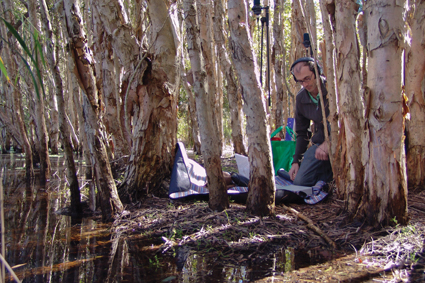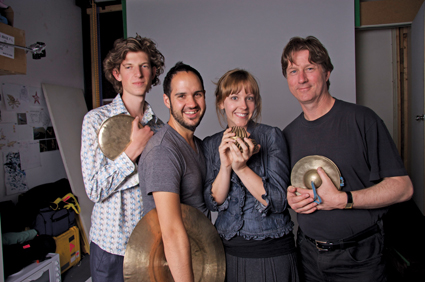 |
New Music Network members, top; Erik Griswold |
The seemingly tireless Network Manager, Philippa Horn, is at the front desk of many of the network’s concerts, welcoming audiences, selling tickets, serving wine. The organisation’s amiable president, James Nightingale, who performs with Continuum Sax and produces the Concert Series with member input, is often present as well. I spoke with Horn and Nightingale recently about New Music Network, its history and its strategies for promoting new music—a truly challenging but, it seems from their joint enthusiasm, rewarding task.
New Music Network started in 1995 as a Sydney based organisation, says Nightingale, at the prompting of new music stalwarts Daryl Buckley and John Davis, who convened the initial meeting at the Australian Music Centre with founding members austraLYSIS, Contemporary Singers, Coruscations, Elektra String Quartet, ELISION, Machine for Making Sense, The Song Company, Spring Ensemble, Sydney Alpha Ensemble, Sydney Metropolitan Opera, The Seymour Group, Synergy Percussion, SIMA and Voiceworks. Initially, says Horn, “the meetings were about sharing mailing lists and cross-promoting each other’s activities.” Nightingale adds that the focus was “to lobby the cause of contemporary music, to find economies through collaborative ventures and to build audiences.”
The subsequent years weren’t easy ones in terms of continuity and funding, but in 1999, the NSW government provided support for administration, plus an event, the Peggy Glanville-Hicks Address with a performance. This would later form the beginnings of the concert series envisaged by Marshall McGuire and Roland Peelman. More substantial funding was granted by the NSW Government in 2003 and the main concert series commenced, quickly joined by the mini series. In 2008 the Music Board of the Australia Council also became a significant supporter. Now the Network has some 30 members and an annual national program of activities including the New Music Concert Series, the New Music Mini Series and the Glanville-Hicks Address.
 |
members of Speak Percussion courtesy New Music Network |
“When we decided to go across the border,” says Nightingale, “it was with a combination of desires.” These included expanding the network but also hoping that they could help groups perform in their own cities as well as in other states. Horn is proud that “this is the first year we’ve presented concerts from our main members in both Melbourne and Brisbane, and we have a Mini Series Concert in each city.”
Horn and Nightingale feel that the signs are good, that the organisation is seriously realising its goals. Partly this is because of the aforementioned inclusivity—they cite the membership of Melbourne sound installation artists Madeleine Flynn and Tim Humphrey [RT98] who jointly act as Secretary to the network’s Executive Committee. Horn sees cross-media membership as important for the organisation, along with new platforms and venues, like Campbelltown Arts Centre, west of Sydney “with their extremely strong focus on new music.” The centre is now a member of New Music Network—a significant development, says Horn, excited by the potential impact of new regional arts centres for new music.
Wondering how member groups are supported by the network, I’m told concerts are promoted through an e-newsletter to 1,700 recipients nationally, groups are profiled on the network’s website, advice is given about timetabling of concerts to avoid competing dates, there’s a fine brochure and some financial support. However, Nightingale is emphatic that “the intangible benefits of being in the network are often the ones which are the most difficult to promote and yet are the most rewarding. For example, we try in our concert series to promote artistic collaboration between our members. We don’t have money to make that happen, but it does.” The soprano duo Halcyon has recently been collaborating with australYSIS and Song Company with Ensemble Offspring, who will appear with Machine for Making Sense in a performance in Sydney Harbour National Park on November 7.
“The other intangible is the mentoring that goes on for the up and coming groups from those who have been in the scene much longer. Roland Peelman, artistic director of Song Company is the most obvious example with his openness to all the groups he collaborates with—including Ensemble Offspring and Continuum Sax. Being in a concert series that includes Synergy and Song Company, Continuum Sax gains a lot from just seeing how they operate and just how difficult it can be even if they have a couple of staff members. How much work that goes on in the sector is underestimated. Continuum Sax has no administrator, but we are helped by New Music Network.”
Melbourne composer, former Aphids director, current director of Chamber Made Opera and Vice-President of New Music Network is David Young, another valued role model, says Nightingale: “He’s always full of good advice and has shown what can be achieved through multi-artform collaboration. Aphids’ work is not just about music, but it’s really intelligent when it is and that’s something all of us admire and aspire to.”
I wonder about the role of the network in supporting emerging artists. Horn says that “those who participate in the mini-series are so grateful to get an opportunity to perform. We get about 50-60 applications for the series each year from which we can only choose five.”
What do groups generally need? Nightingale explains that it varies from group to group: “Song Company needs very little from us; we benefit from them, and from Synergy too. Other groups we can support in the Concert Series with a substantial fee to pay for their performers. The Mini Series artists receive a token fee.” Horn adds, “And we look after the venues for them as well as promotion and some paid advertising.” Nightingale explains that “with our artistic oversight, the relationship with the ABC’s Australian Music Unit at Classic FM is very strong. They’re extremely supportive of what we do. Being involved in the mini-series opens doors for people. It’s hard to quantify those sort of connections, but that’s what a network is, a set of constantly dynamic, constantly changing relations. The Halcyon and austraLYSIS concert was broadcast and the artists interviewed as part of it.”
It’s surprising that such an effective organisation is administered by Horn a mere two days a week (I bet that doesn’t include front of house duties); she works the rest of the week for the Australian Music Centre. Her role entails scheduling, booking venues, getting marketing and promotion up for the concert series, delivering the e-news and updating the website, calling for applications, preparing budgets and getting grant applications in on schedule.
I ask Horn and Nightingale if their roles are more than labours of love. Nightingale asserts that “the network is something that will have long lasting consequences. I feel that the new music scene in Sydney has really thrived since the concert series started. For a lot of groups it provides a focus around which they can arrange other things and take advantage of the schedule. When you see the younger groups like Chronology Arts [RT97] and Kammer Ensemble with their wealth of activity and the young composers coming out of the Conservatorium; it wasn’t like that a while ago.”
As for audience development, Horn says that every angle is explored, including sharing mailing lists and doubling audiences with collaborative shows. She’s been inspired by partaking of ISCM festivals in Europe (she played a pivotal role in the wonderful Sydney ISCM World New Music Days earlier this year; RT96). “It broadened my horizons to see lots of small presenting organisations similar to us and so many networks, but very well funded, as in Belgium. But here it’s only us.”
Asked if the network is involved in commissioning new works, Nightingale explains that it would not want to compete with its member groups: “Our contribution is making sure that the performances happen. Back in the 1980s and 90s works commissioned were often not performed or if they were they never came around again. It was unsatisfactory on every level and not a good use of the money and dreadful for the artists. The relationships between composers and performers are now evolving in a very positive way—more new work means a lot more performer input and works are developed more collaboratively.”
With its growing membership across Australia, its concert series and the support it offers groups, its encouragement to collaborate and its openness to new platforms, New Music Network has proven itself an invaluable and sustaining part of new music culture. Nightingale says, “Sometimes people think we’re classical and composer based but we bring other models onto the page and when the edges get messy, that’s when it’s most interesting.” I can vouch for that.
New Music Network: 2010 Concerts: Clocked Out, After the Kingfisher’s Wing, composer Erik Griswold, Ian Hangar Recital Hall, Qld Conservatorium, Oct 6, 6.30pm; Machine for Making Sense & Ensemble Offspring, West Head Project V at Middle Head, Sydney Harbour National Park, Nov 7, 4pm; Double Duos, Recital Hall East, Sydney Conservatorium, Nov 21,5pm; Halcyon with austraLYSIS, Music Workshop, Sydney Conservatorium, Dec 15, 7.30pm; www.newmusicnetwork.com.au
RealTime issue #99 Oct-Nov 2010 pg. 46
© Keith Gallasch; for permission to reproduce apply to [email protected]








 back
back